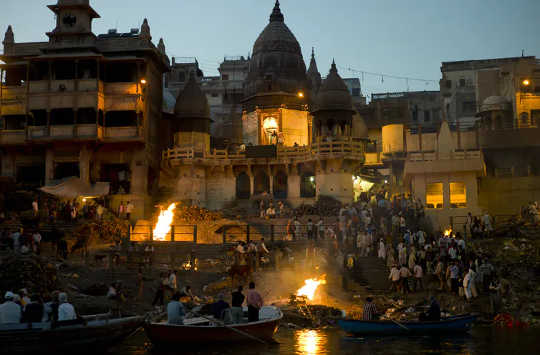
印度的火葬正在印度瓦拉納西的恒河河畔進行。 蒂姆·格雷厄姆/蓋蒂圖片社攝
文化建立了精心的儀式來 幫助人類處理 失去某人的悲傷。
儀式可以容納 核心信念 文化並提供 控制感 in an otherwise helpless situation.在無助的情況下I came to understand this when I lost my mother last year and participated in the primary Hindu rituals of death and grief.去年我失去母親並參加主要的印度教喪葬儀式時,我才明白這一點。
文化習俗和經驗 幫助我找到了失去的意義。
身體和靈魂
Many Eastern religions do not bury their dead;許多東方宗教並未埋葬死者; instead, they cremate them.相反,他們將它們火化。 Most Hindus consider this to be the大多數印度教徒認為這是 最後的犧牲 一個人。
梵語中的“死亡”一詞是:德漢塔”表示“身體的終結”,而不是生命的終結。 One of the central tenets of的核心原則之一 印度教哲學 is the distinction between a body and a soul.是身體與靈魂之間的區別。 Hindus believe that the body is a temporary vessel for an immortal soul in the mortal realm.印度教徒認為,屍體是凡人領域中不朽靈魂的臨時器皿。 When we die, our physical body perishes but our soul lives on.當我們死亡時,我們的肉體會滅亡,但我們的靈魂會繼續生存。
The soul continues its journey of birth, death and rebirth, in perpetuity until a final liberation.靈魂永久地繼續其出生,死亡和重生的旅程,直到最終獲得解放。 This is at the heart of the這是 超脫哲學 並學會放棄慾望。
學者 of Indian philosophy have argued about the importance of cultivating detachment in the Hindu way of life.印度哲學家曾爭辯說,在印度教生活方式中培養超脫的重要性。 An ultimate test of detachment is the acceptance of death.對超然脫離的最終考驗是對死亡的接受。
印度教徒認為,死者的靈魂即使死後仍會依附在屍體上,通過火化屍體可以將其釋放。 作為最後一幕,一個親密的家庭成員用棍子用力敲打著燃燒的屍體的頭骨,好像要使其裂開並釋放靈魂。
為了完全釋放凡人依戀的靈魂,死者的骨灰和剩餘的骨頭碎片隨後被分散在河流或海洋中,通常是在歷史上聖地,例如恒河兩岸。
儀式中的知識
來自不同傳統的人可能會想知道,當一個人應該照顧死者的遺體時,為什麼一項儀式應該要求送葬者摧毀親人的屍體並處置其遺體?
As shocking as it was, it forced me to understand that the burning corpse is only a body, not my mother, and I have no connection left to the body.儘管令人震驚,但它迫使我了解到燃燒的屍體只是一個身體,而不是我的母親,而且我與身體沒有任何联系。 My Ph.D.我的博士學位studies in在...學習 認知科學, a field that seeks to understand how our behavior and thinking are influenced by interactions between brain, body, environment and culture, made me look beyond the rituals.這個領域旨在了解我們的行為和思維如何受到大腦,身體,環境和文化之間的相互作用的影響,這使我的眼光超出了儀式。 It made me understand their deeper relevance and question my experiences.這讓我理解了他們的深層意義,並對我的經歷提出了質疑。
儀式可以幫助我們 了解概念 有 否則難以捉摸 to grasp.掌握。 For example, scholar例如學者 妮可·波文(Nicole Boivin) 描述 物理門的重要性 in rituals of social transformation, like marriage, in some cultures.在某些文化中,諸如婚姻之類的社會轉型儀式中。 The experience of moving through doorways evokes transition and creates an understanding of change.穿越門廊的經歷喚起了轉變,並創造了對變化的理解。
通過儀式, 在那之前還很抽象的想法 例如超支,對我來說很方便。
The concept of detachment to the physical body is embodied in the Hindu death rituals.與身體分離的概念體現在印度教的死亡儀式中。 Cremation creates an experience that represents火葬創造了一種代表 死者身體的盡頭。 Further, immersing ashes in a river symbolizes the此外,將灰燼沉入河中像徵著 最後支隊 流動的水將遺體從凡人世界帶走。
Dealing with the death of a loved one can be incredibly painful, and it also confronts one with the specter of mortality.處理親人的死亡可能會非常痛苦,而且還會使人面臨死亡的陰影。 The ritual of liberating the soul of the dead from its attachments is also a reminder to those left behind to let go of the attachment to the dead.將死者的靈魂從死者的附件中解放出來的儀式,也提醒那些被遺忘的人釋放死者的附件。
For it is the living who must learn to let go of the attachment to the dead, not the long-gone soul.因為活著的人必須學會放開對死者的依戀,而不是放任已久的靈魂。 Cultural rituals can widen one's views when it is difficult to see past the grief.當很難看清悲傷時,文化儀式可以擴大自己的見解。
站在我之前成千上萬出沒的地方,我的祖先們進行了儀式,我放開了母親遺體在恒河聖水中的遺骸。
看著他們隨著古老的河水漂流而去,這使我認識到,這不是終點,而是生活更大圈子中的一小部分。
作為印度文字,“薄伽梵歌” –上帝之歌–談到靈魂,
它不是天生的,它不會死的。
曾經,它將永遠不會。
未出生的,永恆的,永恆的和原始的;
當屍體被殺死時,它不會被殺死。
關於作者
Ketika Garg博士Student of Cognitive Science,認知科學系的學生, 加州大學默塞德分校
books_death






















